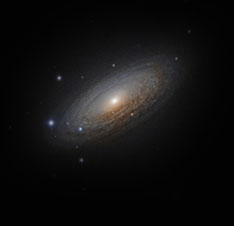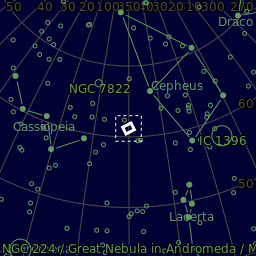
NGC 7635 - Bubble Nebula
The Bubble Nebula was discovered in 1787 by William Herschel in the constellation of Cassiopeia. The nebula is being shaped by fierce stellar winds emanating from the inner hot stars, one in particular that has generated the bubble itself. An extremely bright, massive and short-lived O-type star only 4 million years old has lost most of its outer hydrogen layer and is fusing helium into heavy elements. As the energized gases escape from the star at over 4 million mph, a spherical shock front forms as collision occurs with cooler surrounding nebular gases. Oxygen gas is heated enough nearest the star to emit blue light (doubly ionized oxygen) while the remainder of the nebula glows predominantly in red and yellow, colors mapped here to HII and SII emission. The star appears off center in the bubble (12 O'clock position) as the shock front encounters greater gas density in one direction than the other.
Acquisition Details
Imaging telescope: Stellarvue SV105 APO
Imaging camera: QSI 683 wsg-8
Mount: Orion Atlas EQ-G (belt mod)
Guiding camera: Loadestar X2
Software: Main Sequence Software Seqence Generator Pro, Deep Sky Stacker (DSS), Photoshop CC, PhD Guiding 2
Resolution: 5940x4752
Dates: Sept. 12, 2016, Sept. 16, 2016, Sept. 25, 2016
Frames:
Ha 1.25" 7nm: 26x1200" -20C bin 1x1
O3 1.25" 8.5nm: 31x1200" -20C bin 1x1
S2 1.25" 8nm: 22x1200" -20C bin 1x1
Integration: 26.3 hours
Darks: ~50
Flats: ~50
Bias: ~100
Bortle Dark-Sky Scale: 5.00
RA center: 350.111 degrees
DEC center: 61.179 degrees
Pixel scale: 0.799 arcsec/pixel
Sky Map

toggle image info